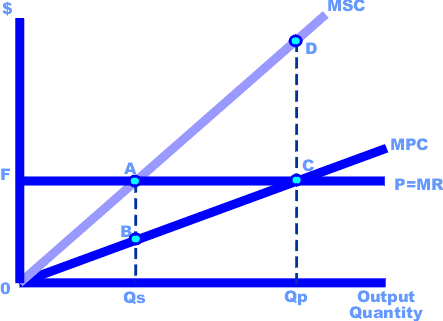Social cost, in economics, is the total of all the costs associated with an economic activity. It includes both costs borne by the economic agent and also all costs borne by society at large. It includes the costs reflected in the organization's production function (called private costs) and the costs external to the firm's private costs (called externalities or external costs).
If social costs are greater than private costs, then a negative externality is present. Environmental pollution is an example of a social cost that is seldom borne completely by the polluter thereby creating a negative externality. If private costs are greater than social costs, then a positive externality exists. An example is when a supplier of educational services indirectly benefits society as a whole but only received payment for the direct benefit received by the recipient of the education: the benefit to society of an educated populace is a positive externality. In either case, economists refer to this as market failure because resources will be allocated inefficiently. (The marginal rate of transformation in production will not be equal to the marginal rate of substitution in consumption due to the effect of the externality and as a result Pareto optimality will not occur -- see welfare economics for an explanation.)
The ideas of social cost and externality are often used in welfare economics as an example of market failure and an argument for government action and against libertarianism. But the existence of market failure is not really an argument for government intervention, since we must also consider the cost of government action and also the existence of alternatives to the government, such as the reliance on tradition or community democracy.
Negative externalities (external costs) lead to an over-production of those goods that have a high social cost. For example, the logging of trees for timber may result in society losing a recreation area, shade, beauty, and air quality, but this loss is usually not quantified and included in the price of the timber that is made from the trees. As a result, individual entities in the marketplace have no incentive to factor in these externalities. More of this activity is performed than would be if its cost had a true accounting.
 External Costs Lead to Excessive Production
External Costs Lead to Excessive Production
This can be illustrated with a diagram. Profit-maximizing organizations will set output at Qp where marginal private costs (MPC) is equal to marginal revenue (MR). (This diagram assumes perfect competition, under which price (P) equals MR.) This will yield a profit shown by the triangular area 0,C,F.
But if externalities are present, the attainment of social optimality requires that the full social costs must be considered. The socially optimum level of output is Qs where marginal social costs (MSC) is equal to marginal revenue (MR). The amount of output, Qp minus Qs, indicates the excess output due to the externality. Profits will decrease also, from 0,C,F to 0,A,F. It is clearly profitable for the firm to pollute, since "internalizing the externality" hurts profits. The amount of the externality will decrease from C,D to B,A.
Because the marginal social cost curve (MSC) is above the marginal private cost curve (MPC), this diagram illustrates the case of a negative externality. If the marginal social cost curve was below the marginal private cost curve, it would be a positive externality and social optimality would require a greater output than Qp rather than a reduction of output.
Pigovian taxes
See main article: Pigovian tax
Because the market mechanism fails to factor in the total cost to society, output decisions are flawed, resources are allocated inefficiently, and social welfare is reduced. One method of reducing the effect of this market failure is to impose a Pigovian tax equal to the amount of the negative externality (or impose a subsidy in the case of a positive externality).
See also